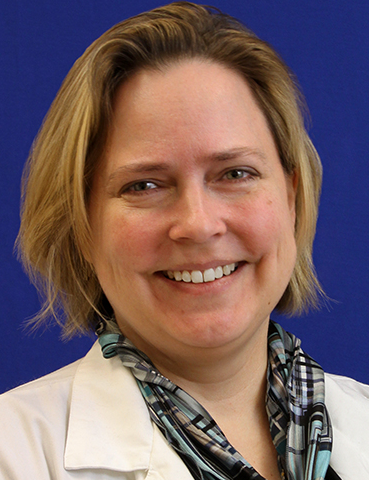Co-Located Conference AgendasCirculating Biomarkers World Congress 2019 | Extracellular Vesicle-based Dx & Rx Summit | Flow Cytometry 2019: Biomarkers & Diagnostics | Liquid Biopsies 2019 | 

Wednesday, 27 March 201908:00 | Conference Registration, Materials Pick-Up, Morning Coffee and Breakfast Pastries | |
Session Title: Conference Plenary Session -- Emerging Themes in Circulating Biomarkers and Liquid Biopsies |
| | |
Plenary Session Chairperson: Lucia R. Languino, Ph.D., Professor of Cancer Biology, Thomas Jefferson University |
| | 09:00 |  | Keynote Presentation Mt-SEA Pipeline: High Throughput Flow Cytometric Analysis of Exosomes in Clinical Biofluids
Jennifer Jones, NIH Stadtman Investigator, Head of Transnational Nanobiology, Laboratory of Pathology, Center for Cancer Research, National Cancer Institute, United States of America
Because Extracellular Vesicles (EVs) carry surface receptors that are
characteristic of their cells of origin, EVs have tremendous potential
as non-invasive biomarkers for diagnosis, risk-stratification, treatment
selection, and treatment monitoring. We developed a first-in-class
pipeline to characterize EV heterogeneity and provide high-sensitivity
quantification of informative EVs in biofluids before, during, and after
treatment. By combining multiplex assays with high-resolution, single
EV flow cytometric methods together into a Mutiplex-to-Single EV
Analysis (Mt-SEA) pipeline, we are able to characterize a broad range of
relevant EV subsets, while also accurately measuring the concentration
of specific EV populations. Detection of tumor-associated EVs and
detection of EV repertoire changes during treatment paves the way to
future evaluation of EVs as as biomarkers for use in personalized,
adaptive therapies. |
| 09:30 |  | Keynote Presentation Disease-Specific Vascular Markers for Cancer, Atherosclerosis and Brain Diseases
Erkki Ruoslahti, Distinguished Professor and Former President, Sanford Burnham Prebys Medical Discovery Institute, United States of America
We study peptides that home to specific targets in the body. We discover
the homing peptides by screening phage libraries for peptides that
direct homing of phages to the target tissue in vivo. The homing
peptides, which usually bind to receptors in the vessels of the target
tissue, can be used to selectively deliver diagnostic probes and drugs
to the target. The latest development is the discovery of
tumor-penetrating peptides. These peptides activate an endocytic bulk
transport pathway we have dubbed the CendR pathway, which can enhance
the exit from blood and tissue penetration co-administered compounds
even without chemical coupling to the peptide (Ruoslahti, Adv Mater.
(2012) 24 3747). We have also identified peptides specific for
atherosclerotic plaques, accumulate at the site of a brain injury or
recognize the blood vessels in Alzheimer’s disease brain. Our homing
frequency have an intrinsic biological active I the disease they target.
Examples of the peptide discovery process from initial screening to
clinical trials will be given. |
| 10:00 | Coffee Break and Networking in the Exhibit Hall | 10:45 |  | Keynote Presentation Precision Medicine Using Liquid Biopsies: A New Paradigm for Managing Cancer Diseases
Steve Soper, Foundation Distinguished Professor, Director, Center of BioModular Multi-Scale System for Precision Medicine, The University of Kansas, United States of America
Precision medicine seeks to match patients to appropriate therapies that optimize clinical outcome from molecular signatures of their disease. These molecular signatures can be secured from circulating markers found in blood (i.e., liquid biopsies). The marker types include circulating tumor cells (CTCs), cell-free DNA (cfDNA), and nanoscale vesicles (exosomes). Unfortunately, many disease-associated blood markers are a vast minority in a mixed population making them difficult to analyze due to deficiencies in current technologies used for their isolation. To address this deficiency, we are generating innovative microfluidic tools for selecting circulating markers from whole blood and determining the presence/absence of disease-specific molecular signatures secured from the liquid biopsy markers to guide therapy for a patient. The microfluidics can process whole blood (=1 mL) and search for CTCs, cfDNA, or exosomes and make them available for downstream molecular processing. The microfluidics are made in plastics via injection molding, making them particularly attractive for clinical implementation, which demands low-cost disposables. In this keynote address, I will discuss our microfluidic platforms for CTC, cfDNA, and exosome isolation. The exosome chip consists of 1.4 million pillars that contain surface-immobilized antibodies directed against antigens from cancer cells that are epithelial based (EpCAM) and those with a mesenchymal phenotype (fibrobast activation protein alpha, FAPa). I will then talk extensively about our exosome isolation chip, and its use in several clinical examples and securing molecular information from the affinity-selected exosomes. |
| 11:15 |  | Conference Chair Exosomes: Novel Opportunities for the Diagnosis and Therapy of Cancer
Lucia Languino, Professor of Cancer Biology, Thomas Jefferson University, United States of America
Our studies have revealed a role for Integrins in mediating
extracellular vesicle (EV) functions. We have demonstrated a cross-talk
between prostate cancer cells and monocytes that promotes
pro-tumorigenic M2 polarization. We have shown that this cross-talk is
mediated by the alphavß6 integrin in EVs and have suggested that
inhibition of this integrin and its downstream effectors might offer a
novel immune – based therapeutic strategy in prostate cancer. We also
demonstrate that the EVs circulating in plasma from prostate cancer
patients contain higher levels of a different integrin, alphavß3, and
CD9 as compared to plasma EVs from age-matched subjects who are not
affected by cancer. We show that the EVs present in plasma from
prostate cancer patients contain higher levels of alphavß3 and CD9 as
compared to plasma EVs from age-matched subjects who are not affected by
cancer. Furthermore, using PSMA antibody-bead mediated immunocapture,
we show that the alphavß3 integrin is expressed in a subset of EVs
characterized by PSMA, CD9, CD63, and an epithelial-specific marker,
Trop-2. Our results suggest that detecting alphavß3 integrin in
prostate cancer patient EVs could be a clinically useful and
non-invasive biomarker to follow prostate cancer progression. |
| 11:45 |  | Keynote Presentation Tumor-derived Exosomes Contribute to a Pro-inflammatory Tumor Microenvironment through the Stimulation of Chemokines and Cytokines in Mesenchymal Stromal Cells and Macrophages
Yves A. DeClerck, Professor of Pediatrics and Biochemistry & Molecular Medicine, Children’s Hospital Los Angeles, University of Southern California, United States of America
Exosomes are members of a large family of extracellular vesicles
involved in cell-cell communication that play important regulatory
functions in physiological and pathological conditions. Using
neuroblastoma (NB), the second most common solid tumor in children and a
cancer that is highly metastatic to the bone marrow and the liver as a
model, we show that NB-derived exosomes contribute to the stimulation of
several protumorigenic cytokines and chemokines (IL-6, IL-8, MCP-1,
VEGF) by mesenchymal stromal cells (MSC) and macrophages via ERK1/2
activation. In vivo NB-derived exosomes are also preferentially
captured by macrophages at the site of metastasis (bone marrow and
liver). Altogether these cytokines promotes the proliferation of tumor
cells, their resistance to chemotherapy and immune escape via STAT3 and
ERK1/2 activation. |
| 12:15 | Networking Lunch in the Exhibit Hall and Poster Viewing | |
Session Title: Circulating Cell-Free DNA (cfDNA) -- A Valuable Circulating Biomarker for Liquid Biopsy Development |
| | 14:00 | Ultrasensitive Detection of Cancer Using cfDNA Methylation Sequencing
Jasmine Zhou, Professor, University of California-Los Angeles, United States of America
The detection of tumor-derived cell-free DNA in plasma is one of the
most promising directions in cancer diagnosis. The major challenge in
such an approach is how to identify the tiny amount of tumor DNAs out of
total cell-free DNAs in blood. Here we propose an ultrasensitive cancer
detection method, termed ‘CancerDetector’, using the DNA methylation
profiles of cell-free DNAs. The key of our method is to
probabilistically model the joint methylation states of multiple
adjacent CpG sites on an individual sequencing read, in order to exploit
the pervasive nature of DNA methylation for signal amplification.
Therefore, CancerDetector can sensitively identify a trace amount of
tumor cfDNAs in plasma, at the level of individual reads. Testing
CancerDetector on real plasma data demonstrated its high sensitivity and
specificity in detecting tumor cfDNAs. In addition, the predicted tumor
fraction showed great consistency with tumor size and survival outcome.
Note that all of those testing were performed on sequencing data at low
to medium coverage (1× to 10×). Therefore, CancerDetector holds the
great potential to detect cancer early and cost-effectively. | 14:30 |  Multiple Biomarker Analysis: New Approaches and Workflow Solutions Multiple Biomarker Analysis: New Approaches and Workflow Solutions
Martin Schlumpberger, Associate Director, Scientific Applications, QIAGEN
Isolation of circulating cell-free biomarkers from different types of body fluids and different entities within these samples, such as circulating tumor cells (CTC) or exosomes and other extracellular vesicles (EVs), poses diverse challenges that need to be addressed. QIAGEN recently released new solutions that include exoRNeasy protocols for isolation of short and long RNAs from EVs in urine, or isolation of cell-free miRNA in higher throughput. Our data demonstrate that utilizing different technology approaches in combined workflows allows collection of meaningful biological data at unprecedented depth, enabling new insights into pathological processes that have a direct impact on clinical research parameters, such as survival statistics.
The applications presented are for molecular biology use only. Not for use in diagnostic procedures.
| 15:00 | Ultra-Sensitive Mutational Analysis in Cell-Free DNA by Digital PCR and NGS Technologies
Rachel Tam, Senior Scientific Researcher, Oncology Biomarker Development, Genentech, United States of America
Circulating cell-free DNA (cfDNA) in plasma offers a non-invasive approach to monitor tumor molecular profiling in real-time at multiple time-points, detection of emerging genomic alterations associated with drug resistance and clarifying cancer prognosis and diagnosis of cancer recurrence or progression. We developed an ultra-sensitive droplet digital PCR (ddPCR) approach and molecular tagged NGS technologies to detect actionable cancer biomarkers in cfDNA. | 15:30 | Afternoon Coffee Break in the Exhibit Hall | 16:00 | Early Cancer Detection in Plasma by Methylation Haplotyping
Kun Zhang, Professor, Department of Bioengineering, University of California San Diego, United States of America
Adjacent CpG sites in mammalian genomes tend to be co-methylated due to the processivity of enzymes responsible for adding or removing the methyl group. This pattern, called methylation haplotypes, can be utilized to detect low levels of circulating DNA from tumor or tumor-residing tissues in the blood. We have developed NGS-based targeted methylation sequencing assays for early detection and location of multiple cancer types in the plasma. In this talk I’ll discuss the underlying principles and present the results on over 3000 samples from multiple cohorts. | 16:30 | Monitoring Recurrence With Personalized ctDNA Assays
Bernhard Zimmermann, Vice President of Research and Development, Natera, United States of America
Signatera™ RUO is the first individualized pan-cancer circulating tumor DNA platform. I will be showing results of validation studies for monitoring treatment response, detecting minimal residual disease and predicting disease recurrence. The test detects tumor DNA down to 0.01% VAF (tumor fraction) and data from clinical studies in lung cancer, bladder cancer, colorectal cancer and breast cancer show that ctDNA is detected in plasma of patients up to over one year ahead of clinical detection of relapse. | 17:00 | cfDNA Analysis in ALK-positive NSCLC Patients and Potential Clinical Utility
Jean-François Martini, Sr. Director, Translational Oncology, Immuno-Oncology, Early Development, Pfizer, United States of America
Lorlatinib exhibited antitumor activity across a variety of ALK kinase domain resistance mutations, including the difficult-to-treat ALK G1202R mutation. Responses to lorlatinib were also seen in patients resistant to prior ALK TKIs and without detectable ALK resistance mutations in plasma. | 17:30 |  | Keynote Presentation Nanodiagnostic Tool for Comprehensive Assessment of Cancer in Blood
Shan Wang, Leland T. Edwards Professor in the School of Engineering, Stanford University, United States of America
Blood borne biomarkers, such as secreted proteins, circulating tumor DNA
(ctDNA) and circulating tumor cell (CTC), have garnered much attention
as minimally invasive cancer biomarkers for the “liquid biopsy” of
tumors over the past decade. In this talk, we will describe three
magnetic-nanoparticle-based diagnostic tools that have been used to
assess cancer in peripheral blood successfully: 1) Stanford spin-off
MagArray Inc. has launched REVEAL, a cancer-specific blood test that may
aid clinicians in characterizing indeterminate pulmonary nodules
(4-30mm) in current smokers aged 25-85. The REVEAL Score is calculated
using an algorithm based on the measurement of 3 clinical factors and 3
blood proteins associated with the presence of lung cancer. The assay is
optimized to rule out lung cancer with a negative predictive value
(NPV) of = 95%. 2) We have developed sequence-specific capture of
hypermethylated or mutated genes of interest from cfDNA for early
detection of NSCLC and colorectal cancer (CRC). With downstream analysis
of PCR products on giant magnetoresistive (GMR) biosensors and
high-resolution melt analysis for a highly multiplexable assay, we have
achieved a sensitivity of 0.01% mutant/methylated allele fractions. Our
optimized assay has the ability to detect down to 16 pg (~4 genome
equivalents) of hypermethylated DNA spiked-in to 3.5 mL of plasma. 3) We
have utilized the MagSifter and immunocytochemistry combined with
automated image analysis and machine learning techniques (random forest,
transfer learning) for the enumeration and diagnosis/prognosis of NSCLC
derived CTCs in patient samples, which are well suited for therapy
selection and monitoring. |
| 18:00 | Networking Reception with Beer and Wine in the Exhibit Hall | 19:00 | Close of Day 1 of the Conference. | 19:30 | Start of Exosomes/Extracellular Vesicles (EV) Training Course [Separate Registration Required to Attend this Training Course] |
Thursday, 28 March 201908:00 | Morning Coffee and Breakfast Pastries Served in the Exhibit Hall | |
Session Title: Liquid Biopsy Development for Cancer |
| | 08:30 |  | Keynote Presentation Biological Functions and Methods of Detection of Large Oncosomes in Cancer
Dolores Di Vizio, Professor, Cedars Sinai Medical Center, United States of America
Extracellular Vesicles (EVs) are important mediators of intercellular
communication pathways that lead to tumor progression, and potential
sources for discovery of novel cancer biomarkers. Recent studies have
shed light on the existence of different populations of cancer-derived
EVs. These heterogeneous EV populations exhibit distinct molecular
cargo, thus pointing to the possibility that the various EV populations
might play diverse roles in cancer and that this does not happen
randomly. However, data attributing cancer specific intercellular
functions to given populations of EVs are still limited. A deeper
functional, biochemical and molecular characterization of the various EV
classes might identify more selective clinical markers, and
significantly advance our knowledge of the pathogenesis and disease
progression of many cancer types. We demonstrated that atypically large
EVs can be shed from highly migratory and metastatic cancer cells. These
EVs, named large oncosomes, play distinct functions and contain a
specific repertoire of molecules that can be used for detection of
tumor-derived cargo in plasma. |
| 09:00 |  Multicolor Flow Cytometry with DuraClone and CytoFLEX Multicolor Flow Cytometry with DuraClone and CytoFLEX
Alina Lelic, Marketing Manager, North America, Beckman Coulter
The simplified workflow of multicolor flow cytometry utilizing the DuraClone dry reagents and CytoFLEX flow cytometer.
| 09:30 | Circulating Tumor DNA Analyses in Lung Cancer
Hatim Husain, Assistant Professor of Medicine, University of California San Diego, United States of America
We will explore current approaches to the implementation of ctDNA strategies in clinical care. Topics that will be discussed are utility studies in early detection, disease monitoring, and monitoring response.
| 10:00 |  | Keynote Presentation Liquid Biopsy in MBC: Real-time Evaluation of Tumor Heterogeneity and Molecular Evolution in Clinical Management
Massimo Cristofanilli, Professor of Medicine, Associate Director of Translational Research and Precision Medicine, Robert H Lurie Comprehensive Cancer Center, Northwestern University, United States of America
Liquid biopsy of solid tumors includes evaluation of both, circulating tumor cells (CTCs) and tumor-derived nucleic acid. Several methodologies demonstrated that both, CTCs enumeration and molecular analysis and, evaluation of circulating tumor DNA (ctDNA) provide a real-time assessment of advanced disease allowing for monitoring of disease heterogeneity. The clinical implementation of such technologies in solid tumors, particularly in breast cancer, demonstrated the ability to elucidate mechanisms of resistance to specific therapies and implement a more personalized, targeted approach to treatment. As such, is necessary to review the current status of liquid biopsy in clinical management of solid malignancies. |
| 10:30 | Coffee Break and Networking in the Exhibit Hall | 11:00 |  | Keynote Presentation Circulating Biomarkers: The New Nanotube-CTC-Microarray Chip for Clinical Impact
Balaji Panchapakesan, Professor, Department of Mechanical Engineering, Worcester Polytechnic Institute (WPI), United States of America
The ability to detect cancer and its heterogeneity non-invasively in the earliest of stages can make a significant clinical impact. Therefore, biopsy of blood and other bodily fluids also called “liquid biopsy” is an emerging concept for non-invasive detection as opposed to surgical methods. Circulating biomarkers is a rapidly growing field of research. Circulating biomarkers include, circulating tumor cells (CTCs), exosomes, circulating tumor DNA (ctDNA), cell-free DNA and RNA (mRNA, miRNA, non-coding RNA, and other RNAs), circulating proteins and metabolites. There are over 400 different methods to capture and analyze circulating biomarkers. However, the clinical impacts of liquid biopsy are yet to be realized. We describe the nanotube-CTC-chip for capture and analysis of circulating tumor biomarkers. Using a micro-array technology, well established in the clinical domain, and utilizing nanosurfaces, we demonstrate the capture and isolation of invasive CTCs, CTC clusters and metastasis initiating cells (MICs). Further, these micro-arrays could be used with little modification to capture exosomes, ctDNA, cfDNA and other protein biomarkers in a single chip. One can also develop nanosequencing techniques using these micro-arrays suggesting a standardized platform for liquid biopsies. |
| 11:30 |  | Keynote Presentation Customized Circulating Tumor DNA Platform for Cancer Research
Cheng-Ho Jimmy Lin, Chief Scientific Officer, Oncology, Natera, United States of America
We have created a ctDNA assay custom-built for treatment monitoring and
minimal residual disease (MRD) assessment. Our methodology identifies 16
unique, clonal, somatic variants individualized to each patient’s
tumor, followed by multiplex PCR and ultra-deep sequencing for
longitudinal ctDNA analysis of whole blood samples. In this talk, I will
be presenting data across four cancer types - including lung,
colorectal, bladder, and breast, and show how determining ctDNA status
longitudinally can be important for patient management and
decision-making. |
| 12:00 | Networking Lunch in the Exhibit Hall and Poster Viewing | 13:00 | Quantitative Detection of Gene Rearrangements Using Circulating Tumor Cells Purified by a Covalent Chemistry-Enabled Platform
Yazhen Zhu, Assistant Professor, David Geffen School of Medicine at UCLA, United States of America
Recent research focus in the field of circulating tumor cells (CTCs) has moved beyond the simple capture or enumeration of CTCs and gravitated towards approaches that allow for in-depth molecular analysis. Unlike circulating tumor DNA or RNA which is highly fragmented and compounded by significant background, CTCs house intact genomic DNA and RNA,providing more reliable genetic information about tumors. Exploring the use of CTC-derived mRNA offers a non-invasive diagnostic solution for understanding underlying tumor biology, guiding treatment intervention, and monitoring disease progression. Recently, we demonstrated a new covalent chemistry-enabled CTC capture/release platform – “Click Chip”. This platform is designed by integrating bioorthogonal ligation-mediated CTC capture (sensitive and rapid) and disulfide cleavage-driven CTC release (mild, specific, and rapid) on nanostructured substrates to enable more efficient purification of pooled CTCs with high-quality intact CTC-derived mRNA. The CTC-derived mRNA was subjected to RT-droplet digital PCR (RT-ddPCR). ALK/ROS1 rearrangements were quantified using CTC-mRNA recovered by Click Chips and matched with those identified in biopsy specimen in late-stage ALK/ROS1 positive NSCLC patients. Moreover, copy numbers of ALK/ROS1 rearrangements in CTCs and CTC counts could be used together for evaluating ALK/ROS1-TKI treatment responses and disease progression. This streamlined diagnostic workflow is optimum for gene rearrangement detection and quantification based on high-quality intact CTC-derived mRNA. | 13:30 |  | Keynote Presentation Multi-Omic Liquid Biopsy Platform
Sam Hanash, Director, McCombs Institute for Cancer Detection and Treatment, University of Texas MD Anderson Cancer Center, United States of America
Multiple technologies are currently being explored for liquid biopsy applications beyond genomics, including proteomics, metabolomics, immunomics and extra-cellular vesicles. The individual and combined contributions of these approaches will be presented. |
| 14:00 |  | Keynote Presentation New Molecular Approaches of Blood Biopsy To Monitor Melanoma Patients Progression During Treatment
David Hoon, Professor, Director Department of Translational Molecular Medicine, John Wayne Cancer Institute, United States of America
Will present new platforms to assess blood biopsy in melanoma patients receiving therapy. New approaches in assessing the utility of CTC and cfNA detection. |
| 14:30 |  | Keynote Presentation Extracellular Vesicles (EVs) For Liquid Biopsy
John Nolan, CEO, Cellarcus Biosciences, Inc., United States of America
Extracellular vesicles (EVs) are released by all cells, and carry molecular from the cell of origin, making them attractive targets for biomarker and liquid biopsy development. In particular, the possibility to interrogate EVs in biofluid to identify tumor-, stroma-, and immune-derived EVs could lead to new biomarkers for disease diagnosis and treatment. However, EVs are heterogeneous, small, and difficult to measure, and commonly used EV analysis techniques lack the specificity and sensitivity required for robust biomarkers. Flow cytometry (FC) is a powerful tool for analyzing single cells and there is interest to use FC to measure individual EVs, but the small size and dim optical signals produced by EVs challenge the sensitivity and resolution of conventional FC-based approaches. We have developed FC-based approaches to detect and measure EVs as small as ~75 nm and cargo to 30 molecules per vesicle. We are using these tools to understand the release of EVs from tumor cells and to detect them in biofluids for biomarker development. |
| 15:00 | Characterizing Cell-Free Circulating RNA - A Dream or a Reality?
Kai Wang, Principal Scientist, Institute for Systems Biology, United States of America
Circulating RNA, especially RNA encapsulated in lipid vesicles, has gained significant interest due to their biological function and possible clinical applications. Despite the potential utilities, it is still a challenge to accurately profile the circulating RNA. Some of the challenges and technology improvements on characterizing cell-free circulating RNA will be addressed. | 15:30 | Afternoon Coffee Break in the Exhibit Hall | 16:30 | Circulating Tumor DNA Methylation Markers for Diagnosis and Prognosis of Hepatocellular Carcinoma
Kang Zhang, Founding Director, Institute for Genomic Medicine, University of California-San Diego, United States of America
We identified an HCC-specific methylation marker by comparing HCC tissue and normal blood leukocytes and showed that methylation profiles of HCC tumor DNA and matched plasma ctDNA are highly correlated. We constructed a diagnostic prediction model with high diagnostic specificity and sensitivity and was highly correlated with tumor burden, treatment response, and stage. Additionally, we constructed a prognostic prediction model that effectively predicted prognosis and survival. | 18:00 | Industry Panel Discussion Focusing on Circulating Biomarkers & Liquid Biopsy | 19:00 | Close of Day 2 of the Conference Track |
Friday, 29 March 201908:30 | Morning Coffee and Breakfast Pastries Served in the Exhibit Hall | |
Session Title: Late-Breaking Session |
| | 09:00 | Highly Sensitive Direct Quantification of cfmiRNAs for Biomarker Profiling by Next Generation Sequencing (NGS)
Sergio Barberan-Soler, Director of Sequencing Technologies, Somagenics, Inc, United States of America
Inefficient and inaccurate profiling of microRNAs from biofluids has hindered their usage as biomarkers. We have developed accurate library preparation technologies to profile microRNAs directly from biofluid samples. | 09:30 | Applying ctDNA and Other Liquid Biopsy Technologies for Oncology Translational and Clinical Research
Brian Dougherty, Executive Director, Translational Genomics, Oncology IMED, AstraZeneca R&D, United States of America
For over seven years, AstraZeneca’s Translational Science Oncology group has applied NGS technologies to patient testing, particularly in the liquid biopsy space. Discussion of our experiences will include: - Opportunities and challenges in ctDNA testing for mutational profiling, patient selection, and patient monitoring
- Orthogonal bench-marking study of commercial ctDNA assays
- One finding: in current testing, most tumor-plasma discordance is due to assay technical performance, not tumor heterogeneity or clonal hematopoesis
- Landscape of the exosomal transcriptome and some potential implications for use for cancer patient testing
- Single cell DNA and RNA technologies
- Testing of patient samples from hematological cancers by single cell sequencing
| 10:00 | BloodPAC: Establishing Standards to Accelerate Development and Approval of Liquid Biopsy Technology
Lauren Leiman, Executive Director, Blood Profiling Atlas in Cancer (BloodPAC), United States of America
The Blood Profiling Atlas in Cancer (BloodPAC) looks to improve outcomes for patients with cancer through a collaborative infrastructure that enables the sharing of information between stakeholders in industry, academia and regulatory agencies. The goals of BloodPAC are: to aggregate, make freely available, and harmonize for further analysis: i) data from CTC, ctDNA, proteins including tumor associated autoantibodies, and exosome assays, ii) associated clinical data, and iii) sample collection, preparation and handling protocols. | 10:30 | Toward Perfect Detection of Un-amplified Biomarkers with Single-Molecule Kinetic Fingerprinting
Alexander Johnson-Buck, Research Assistant Professor, University of Michigan, United States of America
Conventional techniques for detecting rare DNA and RNA sequences require many cycles of PCR amplification for high sensitivity and specificity, potentially introducing significant biases and errors. In addition, some classes of biomarkers, such as epigenetic modifications and proteins, cannot be amplified directly. While amplification-free methods exist, they rarely achieve single-molecule sensitivity; furthermore, even when such sensitivity is achieved, the ability of most methods to discriminate between single-nucleotide variants is often dictated by the specificity limits of hybridization thermodynamics and/or nonspecific binding of probes to assay surfaces. We show that a direct detection approach using single-molecule kinetic fingerprinting can surpass the thermodynamic discrimination limit by three orders of magnitude. This approach detects mutations as subtle as the drug resistance-conferring cancer mutation EGFR T790M (a single C>T substitution) with an estimated specificity of 99.99999%, surpassing the single-base selectivity of leading PCR-based methods and enabling detection of 1 mutant molecule in a background of at least 1 million wild-type molecules. This level of specificity revealed rare, heat-induced cytosine deamination events that introduce false positives in PCR-based detection, but which can be overcome in our approach through milder thermal denaturation and enzymatic removal of damaged nucleobases. Using super-resolution analysis methods, the dynamic range of the technique is increased to approximately five orders of magnitude, comparable to that of droplet digital PCR. We also explore methods of increasing sensitivity in surface binding assays through rational engineering of mass transfer to the imaging surface, and in some cases achieve detection limits in the low attomolar range, an improvement of >50-fold relative to passive diffusion alone. These results suggest the utility of single-molecule kinetic measurements for the direct, digital detection of nucleic acids and other analytes with extremely high specificity. | 11:00 | Close of Conference |
|


 Add to Calendar ▼2019-03-27 00:00:002019-03-29 00:00:00Europe/LondonLiquid Biopsies 2019Liquid Biopsies 2019 in Coronado Island, CaliforniaCoronado Island, CaliforniaSELECTBIOenquiries@selectbiosciences.com
Add to Calendar ▼2019-03-27 00:00:002019-03-29 00:00:00Europe/LondonLiquid Biopsies 2019Liquid Biopsies 2019 in Coronado Island, CaliforniaCoronado Island, CaliforniaSELECTBIOenquiries@selectbiosciences.com